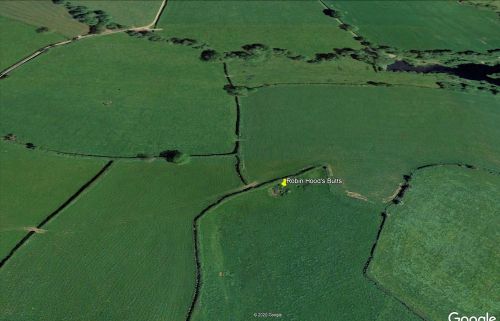Robin Hood's Butts (Combridge)
| Locality | |
|---|---|
| Coordinate | 52.93673, -1.871246 |
| Adm. div. | Staffordshire |
| Vicinity | c. 630 m W of Combridge; c. 3 km N of Uttoxeter |
| Type | Natural feature |
| Interest | Robin Hood name |
| Status | Defunct? |
| First Record | 1658 |
| A.k.a. | Robin Hood's butts |
By Henrik Thiil Nielsen, 2020-10-16. Revised by Henrik Thiil Nielsen, 2021-02-13.
An alleged 'low' or barrow west of Lowfields, near Combridge, about 3 km north of Uttoxeter, was known as 'Robin Hood's Butts', apparently as early as 1658. According to an archaelogical field investigator who visited the site no later than 1957, the feature which was interpreted by an antiquary and a local historian as a prehistoric monument is 'obviously a fairly modern plantation ring'.[1] According to local tradition, Robin Hood shot an arrow there from some point in Stubwood, c. 2.5 km to the north-northeast.
Robert Plot in his Natural History of Stafford-shire (1686) notes what he takes for a Saxon burial mound 'in a place call'd Low-field about a quarter of a mile West from Combridg'.[2] In 1865, the local historian Francis Redfern notes that '[a] barrow still exists at Lowfields with trees growing upon it' (see Allusions below). He cites the name 'Robin Hood's Butts' and mentions a tradition to the effect that arrows shot by Robin Hood from some place in Stubwood (c. 2.5 km NNE) called White Gate had landed on the mound. According to a tradition current among local peasants, at one time a battle had been fought at Lowfields. Redfern concludes that the mound, which he notes was 'but slightly elevated above the surrounding surface', may have been part of a cemetery from that time. He gives a somewhat more elaborate account in the second edition of his local history of Uttoxeter, published 1886 (see Allusions below). The 'old survey of Uttoxeter parish' he cites in the latter as source for the name 'Robin Hood's Butts' should almost certainly be identified with Peter Lightfoot's 'Survey of Uttoxeter' (1658).[3]
The field investigator's report of c. 1957 finds 'no trace of a barrow or anything else of significance' and states that '[t]he circular bank and ditch described by Redfern is [sic] obviously a fairly modern plantation ring'.[4] IRHB has not been able to identify the 'White Gate' in Stubwood at which Robin Hood was said to have been standing when performing his feats of flight shooting.
Allusions
1865 - Redfern, Francis - History of Town of Uttoxeter (1)
1886 - Redfern, Francis - History and Antiquities of Town of Uttoxeter (1)
Gazetteers
- Not included in Dobson, R. B., ed.; Taylor, J., ed. Rymes of Robyn Hood: an Introduction to the English Outlaw (London, 1976), pp. 293-311.
Sources
Maps
- 25" O.S. map Staffordshire XXVI.6 (1882; surveyed 1880–81)
- 25" O.S. map Derbyshire XLVII.6 (c. 1901; rev. c. 1898-99). No copy in NLS
- 25" O.S. map Derbyshire XLVII.6 (1922; rev. 1920) (georeferenced)
- 25" O.S. map Derbyshire XLVII.6 (1922; rev. 1920)
- 6" O.S. map Staffordshire XXVI.NW (1886; surveyed 1880–81)
- 6" O.S. map Derbyshire XLVII.NW (1901; rev. 1899) (georeferenced)
- 6" O.S. map Derbyshire XLVII.NW (1901; rev. 1899)
- 6" O.S. map Derbyshire XLVII (1924; rev. 1920)
- 6" O.S. map Derbyshire XLVII.NW (1924; rev. 1920).
Background
Also see
- Combridge place-name cluster
- Places named Robin Hood's Butts
- Places connected by bowshot
- White Gate (Stubwood).
Notes
- ↑ PastScape: Monument No. 305037.
- ↑ Plot, Robert. The Natural History of Stafford-shire (Oxford, 1686), p. 414. Plot's italics.
- ↑ For which see Redfern, Francis. History of the Town of Uttoxeter: with Notices of Places in its Neighbourhood (London; Uttoxeter; Derby, 1865), pp. x-xi.
- ↑ PastScape: Monument No. 305037.
- ↑ Redfern, Francis. History of the Town of Uttoxeter: with Notices of Places in its Neighbourhood (London; Uttoxeter; Derby, 1865), p. 26.
- ↑ Redfern, Francis. History and Antiquities of the Town and Neighbourhood of Uttoxeter: with Notices of Adjoining Places. Second Edition (Hanley; London; Uttoxeter, 1886), pp. 86-87.

